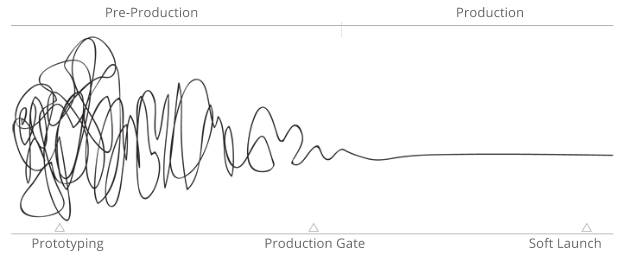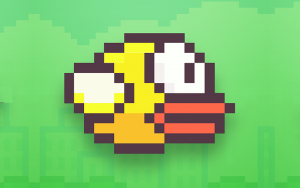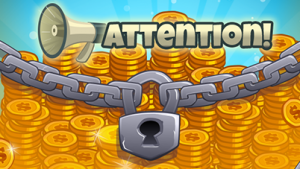Why Games Fail: Pre-Production
Every project that I’ve seen fail, the team always says one thing in their Post-Mortem: “We should’ve done more Pre-Production!”
It is the tell-all excuse. Teams always place the blame on the Pre-Production phase.
Why didn’t we figure this out before we went to Production? Why did we rush into production when there was so much left to solve? How did we not see the monster this game would become?
How do we solve this? How do we get to the point that we avoid projects going into Production that are just going to explode in scope or the design falls apart?
Mark Cerny’s “Method”
Back in 2002 during a DICE Summit, Mark Cerny, a Producer on various Naughty Dog projects, presented “Method”. Mark Cerny offered a solution to the problem that faces complex game development: a better approach to Pre-Production.
Mark argues that most games fail solely because they haven’t done Pre-Production properly. Production is not the time for teams to be discovering what will make them successful.
This was presented in 2002. Game Development has changed drastically since then. For instance, developers now can release at the press of a button. We now use soft launches and analytics to test games while live. We don’t have the weight that comes with having to launch a physical product. However, despite the benefits of modern game development, much of what Mark speaks about still applies. Many projects fail, pointing back to a failed Pre-Production.
So what can we apply from this talk to modern game development?
“You will spend a million dollars before you know what your game is…”
There remains two distinct phases in Game Development: Pre-Production and Production. Pre-Production is for when you are “capturing lightning in a bottle” a.k.a. identifying what makes you different, what will make your game a hit game. Production is for when you know you have a hit, you just need to deliver it.
The goal of Pre-Production is to reach a state which you are confident that your game will be a hit.
Pre-Production is also about defining key variables, economies, mechanics enough such that you can start producing final content for your game. Yet to reach this ideal point is extremely difficult.
Pre-Production phase can last a long time, and can’t really be tracked. Finding how to pull all the pieces of a working game together into a publishable package is a very elusive process that can take months or even years. Free-to-Play games in comparison to traditional PC games I would argue have more moving parts. Session design, economy design, social mechanics, elder game design must all come together on top of having your core gameplay completely nailed down.
My rule of thumb is Pre-Production for free-to-play games should last anywhere from 3 months to a year. It will take you at least that long to properly prototype & iterate your metagame and economies. If you aren’t taking this much time, then you’re either cloning a game (in which you don’t need Pre-Production nor a conscience), or you aren’t spending enough time nailing down your game’s design. How long you need in Pre-Production is dependant on the team’s experience level. If you are creating a game within a genre you know, this can take 3 months. If you are exploring genres you have never created in this can take at least a year, if not more.
Pre-Production for free-to-play games should last anywhere from 3 months to a year.
A whole year on Pre-Production? That seems ridiculous! Yet in reality, spending this much time in Pre-Production pays dividends during production. If you reach this ideal — having a clear definition of what makes your game unique, all game variables are defined and your metagame is nailed down, Production becomes near trivial. When you scale up your team, you will spend far less time in Production. So instead of Production taking years on a game with 20-30 people, it takes just 6 months. You will avoid many pivots that happen in production, when the cost of change is very high.
So be prepared to spend a million dollars in Pre-Production. It will be worth it come time for production.
“A Publishable Prototype”
The goal of Pre-Production is to define what makes your game great. Prove to yourself, your team, and all stakeholders that this game will become a success. The best way to do this is to produce a complete prototype which proves your game is great.
What does a complete prototype look like? It is an ugly, cheap version of your game that is playable on device. But it has the full game loop: all the economy systems, all the gameplay mechanics, and everything that you think is absolutely required to prove that your game will become a success. All in one prototype. It should feel as close to the final game as possible, while being as cheap as possible to produce. Art can help, but should not be the focus.
I choose a complete prototype over a bunch of small prototypes because game design is extremely interconnected. To truly prove how your game will ultimately feel, you have to put it all together. The effects of a design decision are not always apparent until you play with the systems interacting with each other. This can take more time than necessary, but this has proven time and time again to identify unseen problems in my own game design.
Complete prototypes identify problems that separate prototypes can’t.
The team’s role during Pre-Production is to produce this complete prototype. Build the experience of the final game as quickly as possible. You will find that through many iterations, what you initially felt was going to make the game successful changes with each release. This is natural and necessary. When you build a complete prototype that feels as close to the final version as possible, many issues arise that you typically wouldn’t find out about until close to launch. The key with prototypes is to build your game into the monster it will become as quickly as possible.
But when is this prototype done? When are we ready for Production?
To define how to reach Production, I create a checklist. This checklist provides a vision about what we must prove before we enter production.
To create this checklist :
Conduct a Pre-Post-Mortem, imagine how your Project could fail. Define what the biggest risks are for your project:
- Define what must be amazing in order for your game to be successful.
- Define what can kill the project you if you get wrong.
- Define what assumptions must be confirmed before you start producing final content.
When you feel confident that you’ve done all you reasonably can to hit each of these points, then it is time to move to Production.
Just keep in mind:
“Your Product will not miraculously get better in Production”
If there are core design problems in Pre-Production, don’t expect them to go away with simply adding more content in Production.
“A cancelled product is not a reflection of the team’s ability.”
The goal of Pre-Production is to do everything possible to kill your game — not to protect your game from any chance of failure. As a team you must eliminate risk and spot when the risk is just too high. Killing a game in Pre-Production needs to be accepted. Killing a game saves money, time and years of emotional strain on any team member involved. A failed prototype is a celebration.
Summary
The keys of a strong Pre-Production are:
- Make time for exploration and defining what makes your game great. Give at least 3 months to 1 year depending on the experience of the team.
- The team must be focused on delivering a complete prototype which reduces as much design risk as possible.
- To enter Production, you must define your design risks. Create a checklist of these risks and ensure they are fixed before entering production.
As massive scale 3D productions become the norm, a strong Pre-Production process will become far more important.







